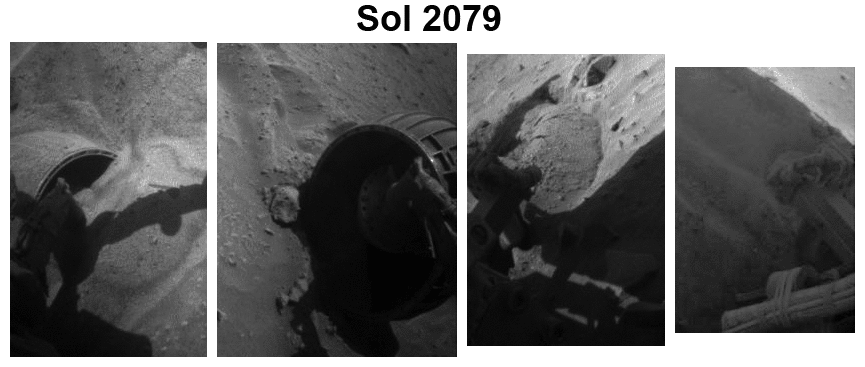Emily Lakdawalla • Nov 17, 2009
Results of the first "Free Spirit" extrication drive, sol 2088: not much, as expected
EDIT: JPL's update for today indicates the drive stopped after less than 1 second of driving because it sensed its tilt was out of the tightly specified parameters, which would explain why there appeared to be basically no change between the "before" and "after" frames. Try again on sol 2090!
Even though all of us rover fans know that Spirit is really, really stuck, I think I'm not the only one who was secretly hoping that today's images downlinked from Spirit would show that the rover had magically popped out of the ground overnight. Of course, she didn't. We're in this for the long haul. Patience, patience.
So here's what did happen. Last night, the Jet Propulsion Laboratory issued a brief update on the commands that were being prepared for uplink to Spirit to start the first attempt at driving since Spirit got stuck at Troy six months ago. Sol 1898 was the last Martian day of attempted driving; it's now sol 2088 at Gusev crater, and overnight Spirit was commanded to make two tiny "steps", each 2.5 meters' worth of wheel motion. JPL is now planning to issue these short updates once daily to brief Spirit's supporters on every slow and painful step in the extrication process.
These commanded drives were not really expected to pop Spirit out of the sand trap. Rather, they represent an attempt to verify that the engineers on Earth can accurately predict the behavior of Spirit on Mars. After the motion was over, Spirit was instructed to take a thorough series of photos documenting the post-drive position. They include the usual front and rear Hazcam images and Navcam frames. Spirit was also instructed to take and return back to Earth side-looking Navcam images captured during the drive as part of the rover's autonomous visual odometry ("Visodom") capability. Unusual sets of images included in the documentation photos are Pancam frames designed to peer through windows in the rover's deck to spot the middle wheels, and Microscopic Imager photos of the rover's underbelly, to document the position of a pointy rock located underneath the rover.I don't yet know whether the entire driving sequence executed as planned. We now know the drive faulted out after one second because of very conservative limits set on the rover's self-monitoring of its tilt. The expected number of images did show up on the Exploratorium servers that host rover raw images. You can get to the front haz, rear haz, pancam, navcam, and microscopic images through those links. I can show you these before-and-after comparisons of the Hazcam views of the rover's wheels. Except for shadow motion, there is virtually no change from sol 2079 to sol 2088. A minute shift in perspective indicates a tiny amount of rover motion. But there's no obvious change in the appearance of the dirt around the rover wheels.

The team will spend Tuesday analyzing these images and the other health data that Spirit sent back to Earth. The next drive attempt will occur no earlier than sol 2090. As of the time that I write this, it's just past 10 pm on sol 2088 for Spirit.
The Time is Now.
As a Planetary Defender, you’re part of our mission to decrease the risk of Earth being hit by an asteroid or comet.
Donate Today

 Explore Worlds
Explore Worlds Find Life
Find Life Defend Earth
Defend Earth

